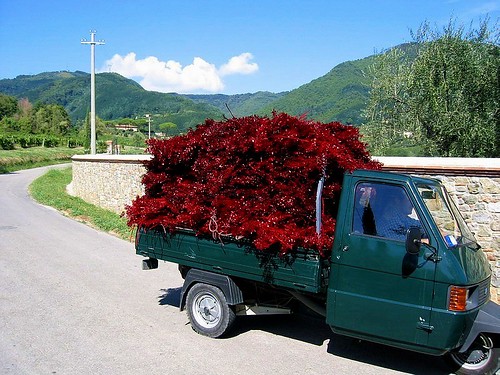You might have heard of Piaggio, the Italian scooter manufacturer and its “Vespa” model. Two wheeled transport is very popular in Italy, especially with smaller 50 and 125cc engines. The countryside is often hilly, towns and villages are never far away, and frequent good weather all combine to make this mode of transport very practical and suitable.
If vespa is Italian for wasp, then note ape means bee, you say “ah-peh”. It’s this that gives its name to the Piaggio Ape, a three wheeled scooter with a flatbed at the back. These are quintessential Italian. Modern pizza is everywhere and partly an American invention; talking with big hand gestures is common all round the Mediterranean. No, I think the Ape is something you’ll find in Italy and nowhere else.
Of course the country has many other unique traits, but from the cyclist’s perspective, you will find the Ape buzzing around all over the country. It makes sense. Cheap and economical to run, they share many parts and features with the standard Piaggio scooters, allowing service by the owner or in one of many garages.

The flatbed at the back isn’t huge but serves to carry a day’s produce from the greenhouse to the market stall or enough building materials and tools to keep workers busy for a morning before they head home for lunch. Plus they are small enough to fit through many a medieval town centre, when streets only had to be wide enough to let two mules pass.
Motorpacing
They are also useful for impromptu motor-pacing sessions. Laden with crates of fruit even the most occasional cyclist has a power to weight ratio to match the 50cc version. Just be warned that they don’t handle well, if there’s a bend in the road up ahead it’s time to ease back.
Made in Turin
Piaggio itself is an Italian industrial giant. From Torino, the largest manufacturing base and home of Fiat and its Lingotto plant, at the time Europe’s largest factory and one of the first places to employ Ford-like mass production methods in Europe.
Piaggio began in aviation indeed it still continues today with Piaggio Aero. But following World War Two the Italian army was obviously subdued and a wider population required cheap transport. The moped was born. Two wheels are not unique to Italy, indeed they are common across Europe and beyond. But the three wheeled Ape has yet to cross the Alps in meaningful numbers. Although sales are apparently booming in India.
Anyway, if you are lucky enough to ride on Italian roads you are bound to see these, whereas visit neighbouring countries like France, Switzerland or Austria and you will find great roads but not these amusing little trucks.
Italian Cycling Part I – The Ape
Italian Cycling Part II- Regions


Super nitpicky: it’s pronounced “AHP-ay” with the ay being like ‘pay’ in English. Those things are indeed fun to ride behind.
I definitely missed them when we lived in Austria – there they tend to have much larger faster trucks that can be a bit unnerving when coming the other way on still very narrow mountain roads. Much nicer a friendly little Ape puttering along.
The Ape is one of my favourite things about Italy. I always think of it as the modern equivalent of the donkey.
And you’re right about it’s uniqueness to Italy. A few years ago I spent a week in the south-east of France and I don’t think I saw a single one and yet the following week just across the border in Italy they were everywhere.
That said, where I live in Scotland someone has one. It makes me smile every time I see it.
Thanks David, advising on pronunciation is hard but that’s right.
Struan: I find it unique and like you that’s why I included it as the first example. Obviously in time I’ll cover things like the Alps and more.
I wish the two-stroke APE’s would go away, the exhaust is nasty stuff whether you motorpace behind them or let them pass. In many towns you see them with roll-bars and racing stickers — seems young boys like to race around on them through the city streets, getting up on two wheels through the sharp turns. My favorite memories of them (cough, cough) are when you see the old farmer AND his wife B OTH wedged into the cab, heading down to the market, or on nicer days, the farmer’s wife might be sitting in the back as they head to town for the weekly shopping! Counting the days until we get over there for our 2011 season!
Not just Italy – you find variations of the Ape in the Indian subcontinent as well, although they are getting rarer.
After WW2 Italy had restrictions imposed on it in terms of what industrial manufacturing they could have. As I understand it this precluded any aeronautical manufacturing. This caused many companies to diversify their manufacturing and as you say Italians needed cheap transport. These restrictions were also part of Lamborghini’s diversification from Helicopters into tractors, then ultimately into sports cars.
where in the U.S can I buy a paiggio ape scooter pickup